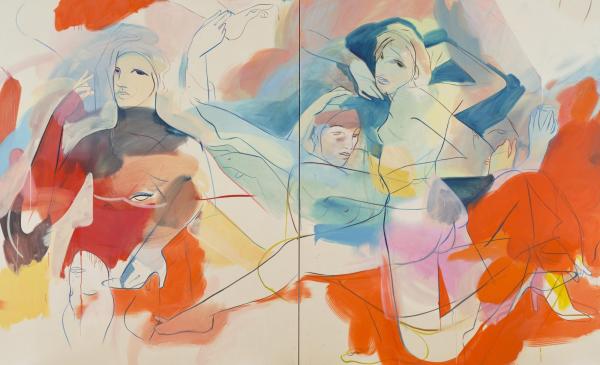In 2018, Salvador Dalí’s Lobster Telephone, 1938 became a major addition to the Scottish National Gallery of Modern Art’s world-class collection of Surrealist art. The acquisition was made possible thanks to very generous assistance from the Henry and Sula Walton Fund and the Art Fund.
Lobster Telephone was made for the British poet and patron of the arts, Edward James (1907-1984), who was Dalí’s main patron from 1936 to 1939. Eleven of the plaster lobster receivers were made to fit telephones at James’s homes in London and Sussex; seven of them were painted white and four were painted red. James was born in 1907 at his family’s summer house, Greywalls, in Gullane, near North Berwick. His family was immensely wealthy, owning a vast estate at West Dean, near Chichester in West Sussex. Edward came into his inheritance in his twenties and used much of it to support the arts: he is best known as the patron of Salvador Dalí and René Magritte.
He met Salvador Dalí (1904-1989) in Cadaqués in Catalonia in 1934, and they became close friends. Dalí visited James in London on several occasions and James bought many of the artist’s greatest paintings, straight off the easel. While some of these works remain in Britain, many were sold abroad in the 1970s and 1980s. From the mid-1930s, James had his house in central London at 35 Wimpole Street, and his country house, Monkton, on the West Dean estate, redesigned and given Surrealist makeovers. Dalí designed furnishings including the celebrated Mae West Lips sofas, which were shaped in the form of the Hollywood actress’s lips, tall lampstands in the form of stacked champagne glasses, and the famous Lobster Telephones. He also came up with the idea of installing walls which would breathe in and out, to give the effect of being inside a dog’s stomach, but James somehow resisted the proposal.

The idea for the Lobster Telephone dates back to a drawing Dalí made in New York early in 1935. Already a famous artist (famous for his antics as much as for his art) and a favourite of newspaper columnists, the popular weekly journal American Weekly commissioned Dalí to describe his thoughts on American culture. He made several drawings, one of which, Man Finds a Lobster Instead of a Phone, shows a horrified man reaching for the phone and realising that it was instead a lobster. The following year, again in New York, Dalí exhibited a live lobster on a red-painted telephone and in January 1938, he showed another ‘lobster telephone’ at the famous Exposition Internationale du Surréalisme, held in Paris. It consisted of a real lobster, balanced on a tall telephone and bore the title ‘Aphrodisiac Telephone’. For Dali, lobsters were sexually charged objects.
Dalí visited Edward James in the summer of 1938 and it seems that they dreamed up the idea of making the fully functioning Lobster Telephones at that time. James commissioned the London interior and furniture design firm Green & Abbott on Wigmore Street, to make the plaster lobsters. They seem to be cast from a real lobster, and were made with great care and attention to detail. The inside of each plaster lobster has been hollowed out to fit snuggly over a telephone receiver, and a hole cast into the tail to take the flex. A metal armature inside the lobster gives it rigidity. There are screw holes on either side, to fix the lobster to the receiver. The tail bends perfectly over the mouth part of the receiver. Green & Abbott also fabricated Dalí’s Mae West sofas.
A letter of Monday 18 July 1938 from Green & Abbot to Edward James, details the commission and states that the lobsters would be varnished and hard by the end of the week.[1] Intriguingly, on 19 July, Dalí and James visited Sigmund Freud, the father of psychoanalysis and one of Dalí’s heroes, at his home in Hampstead; Dalí drew Freud’s portrait. James was invoiced for the lobsters in August.
[1] See Sharon Michi-Kusunoki, ‘Lobster Telephone’, in Dawn Ades, Dalí: The Centenary Retrospective, exhibition catalogue, Palazzo Grassi, Venice and Philadelphia Museum of Art 2004, pp.286-9.
In this film, art historian and curator Dawn Ades discusses Edward James, his relationships with Salvador Dali and Rene Magritte and his Surrealist creation Las Pozas, built in the Mexican rainforest.
The Lobster Telephone is arguably the most iconic of all Surrealist ‘Object Sculptures’: these became a craze in the 1930s, with Man Ray, Joan Miró, René Magritte, Alberto Giacometti, Roland Penrose and Eileen Agar among the many who made them. Instead of making a sculpture by modelling with clay, carving in marble or casting in bronze, the Surrealists took pre-existing objects, put them together, or changed them slightly, and then exhibited them. It was like 3D collage. From a practical point of view, it allowed artists who had no training in sculpture to produce sculptural objects. From an artistic point of view, it enabled artists to produce bizarre objects which instantly challenged conventional norms.
Dalí was one of the first to write about these ‘Object Sculptures’, in an article published in 1931. He wrote that they were ‘based on phantoms and representations liable to be provoked by the realisation of unconscious acts.’[2] Joan Miró wrote what was possibly the most succinct rationale of Object Sculptures: ‘I never think about it in advance. I feel myself attracted by a magnetic force toward an object, and then I feel myself being drawn toward another object which is added to the first, and their combination creates a poetic shock - not to mention their original formal physical impact - which makes the poetry truly moving, and without which it would have no effect.’[3] Exhibitions devoted to Surrealist Object Sculptures were held in Paris in the 1930s, but very few of the originals survive.
[2] Salvador Dalí, ‘Objets surréalistes’, Le Surréalisme au service de la revolution, no.3, December 1931, p.16.
[3] Letter to Pierre Matisse, 28 September 1936, quoted in Margit Rowell (ed.), Joan Miró: Selected Writings and Interviews (London 1987).

The other versions of the Lobster Telephone belong to museums around the world: there are two in the USA, and others in museums in the Netherlands, South Africa, Australia, Germany and Portugal. One is in a private collection abroad. Tate in London has a red version on a black phone. All the Lobster Telephones originally belonged to Edward James, and then to the Foundation that he created in West Dean, but they were sold over the years, to raise funds. The actual telephone elements of the eleven Lobster Telephones all vary slightly. The original 1930s telephones were lost or replaced over the years but replacements were sourced by the Foundation to match the original pyramidal models.
The Edward James Foundation retained one red version on a black telephone, and also this white version, which has been exhibited widely: it was included in the Dalí centenary exhibition held in Venice in 2004. The Foundation decided to sell it at auction late in 2016. It would have left Britain, but in view of its artistic and historical importance, and the fact that it was the last white version left in Britain, it was subject to an export license deferral. Issued on behalf of the Secretary of State, these deferrals allow UK museums the chance to acquire a work by matching the original sale price. Thanks to the Henry and Sula Walton Fund, which was established to help the National Galleries of Scotland acquire major works of modern art, and a grant from the Art Fund, the work was saved and now joins the collection at the Scottish National Gallery of Modern Art in Edinburgh.


